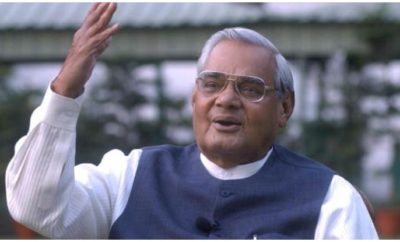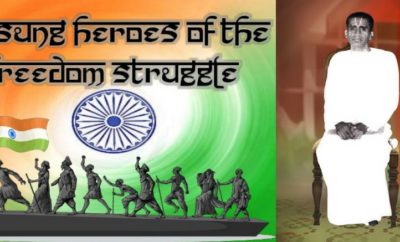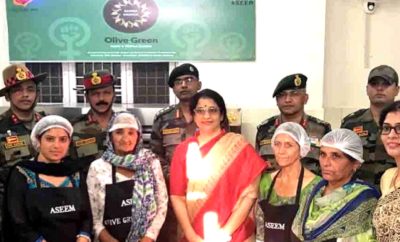
HIstory
25 Lesser known facts about Lord Parashurama
By |
Lord Parshuram is the sixth avatar of Vishnu in Hinduism. He was a brahmakshatriya. Like other avatars of Vishnu, he appears at a time when overwhelming evil prevailed on earth. The warrior class, with weapons and power, had begun to abuse their power, take what belonged to others by force and tyrannize people. Parashurama corrects the cosmic equilibrium by destroying these evil warriors
- Parshurama is the sixth avatar of Lord Vishnu, He is the son of Renuka and one of the saptarishi Sage Jamadagni. He lived during the last Dvapara Yuga, and is one of the seven immortals or Chiranjivi, of Hinduism. He received an axe after undertaking terrible penance to please Lord Shiva, who in turn taught him the martial arts.
- Parashurama is most known for ridding the world of kshatriyas twenty-one times over after the mighty king Kartavirya killed his father. He played important roles in the Mahabharata and Ramayana, serving as mentor to Bhishma, Karna and Drona. Parashurama also fought back the advancing seas to save the lands of Konkan and Kerala.
- The exact birth place of Bhargav Parashurama is contested, although the history of his lineage took place in the Haihaya Kingdom located in modern day Maheshwar. The grandfather of Bhargava Parashurama was a great rishi named Rucheeka, who was son of a famous sage Bhrigu. Parshuram is also the kul guru of Bhardwaj gotra. Parshuram belongs to a gaud Brahmin of bhargav gotra
- The king was taken aback, but could not deny the request of a Brahmin. As such, he agreed to give his daughter away to the rishi, but on condition that Rucheeka give him one-thousand horses, all with one ear black and the body entirely white. The rishi agreed to the demand of the king. He then did penance to Varuna, and was blessed with the horses that the king had requested. Rucheeka then married Satyavati after fulfilling wishes of the King.
- Satyavati adjusted well to an ascetic life as she was blessed with a good countenance, but she did not have any children. Meanwhile, at the kingdom, her father had no heir to the throne as well, and this also worried Satyavati. One day, Rucheeka asked her what was wrong, and she told him of her concerns for the kingdom.
- In time, both mother and daughter found they were expecting children. However, the sage noticed that when he looked at his wife he saw a Kshatriya aura, and he asked what had happened. Satyavati told Rucheeka, to which he responded, ‘Now our son will be a great warrior instead of a sage.” Satyavati begged the rishi to instead make her grandson become the great warrior and her son a rishi.
- The exact location of his birth is contested, although puranas claim that he was born at Renuka Tirth as the sixth incarnation of Lord Vishnu. His father, Jamadagni, was a direct descendant of Brahma. Renuka gave birth to four sons before Parashurama: Vasu, Viswa Vasu, Brihudyanu, and Brutwakanwa. Before the birth of their fifth son, Jamadagni meditated with his wife Renuka at Tape Ka Tiba near Renuka lake for divine providence.
- Renuka was known for her chastity and devotion to her husband. Such was her faith, that she was able to fetch water from the river in a pot of unbaked clay, with the pot held together only by the strength of her devotion. One day while at the river, a group of Gandharvas in a chariot passed by in the sky above. Filled with desire for only a moment, the unbaked pot she held dissolved in the river. Afraid to return to her husband, she waited at the river bank, uncertain of what to do next.
- Pleased, Jamadagni then offered two boons to Parashurama. The boy asked that his mother be brought back to life, and his brothers to be returned from stone to flesh. Impressed by the affection and devotion of his son, Jamadagni granted his request.
- Shri Parashuram left home to do devout austerities to please Lord Shiva. Considering his extreme devotion, intense desire and unmoved and perpetual meditation, Lord Shiva was pleased with Shri Parashuram. He presented Shri Parashuram with Divine weapons. Included was his unconquerable and indestructible axe shaped weapon, Parashu. Lord Shiva advised him to go and liberate the Mother Earth from felons, ill-behaved people, extremists, demons and those blind with pride.
- Once, Lord Shiva challenged Shri Parashuram to a battle to test his skills in warfare. The spiritual master Lord Shiva and the disciple Shri Parashuram were locked in a fierce battle. This dreadful duel lasted for twenty one days. While ducking to avoid being hit by the Trident (Trishūl) of Lord Shiva, Shri Parashuram vigorously attacked him with his Parashu. It struck Lord Shiva on the forehead creating a wound. Lord Shiva was very pleased to see the amazing warfare skills of his disciple.
- Shri Parashurama, clipped the thousand arms of Kartavirya Arjuna(Sahasrarjun), one by one, with his Parshu and killed him. He repelled his army by showering arrows on them. The whole country greatly welcomed the destruction of Kartavirya Arjuna(Sahasrarjun). The king of Deities, Indra was in possession of Lord Shiva’s Vijaya Dhanusha. Indra was so pleased that he presented this most beloved bow named Vijaya to Shri Parashurama on instruction from Lord Shiva.
- Parashurama is unique in that although he is the sixth avatar of Vishnu, as an immortal, he has also lived to see the subsequent incarnations of Vishnu in Rama and Krishna. Parashurama played an important role in both the Ramayana and Mahabharata.
- In the Ramayana, Parashurama had given the bow of Shiva to the father of princess Sita for her swayamvar. As a test of worthiness, suitors were asked to lift and string the mystic weapon. None were successful until Rama, but in the process of being strung, the bow snapped in half. This produced a tremendous noise that reached the ears of Parashurama as he meditated atop the Mahendra Mountains.
- In Valmiki Ramayana, Parashurama stops the journey of Sri Rama and his family after his marriage to Sita. He threatens to kill Sri Rama and his father, King Dasharatha, begs him to forgive his son and punish him instead. Parashurama neglects Dasharatha and invokes Sri Rama for a challenge. Sri Rama meets his challenge and tells him that he does not want to kill him because he is a Brahmin and related to his guru, Vishwamitra maharshi.
- In one version played in Ramlilas across India, Parashurama arrived to the scene deeply angry. The Kshatriyas were advised by Brahmarishi Vasistha not to confront the sage, but Sita still approached. Parashurama blessed her, saying “Dheergha Sumangali bhavah,” or “You will have your husband alive for your lifetime.”
- According to Puranas, Parashurama travelled to the Himalayas to pay respect to his teacher, Shiva. While travelling, his path was blocked by Ganesha, son of Shiva and Parvati. Parashurama threw his axe at the elephant-god. Ganesha, knowing the weapon had been given to Parashurama by his father, allowed it to sever his left tusk.
- According to Hindu tradition, Parshurama reclaimed the land of Konkan after donating the earth to Maharshi Kashyap. Then he requested different Gods and Goddesses to settle in the newly created land and to take responsibility of various clans. Parshuram, being a devotee of Shiva, requested Shiva to give him audience everyday, while he is living in the newly created land. Lord Shiva accepted his request. Lord Parshuram also brought 60 ‘Vipras’ to settle in Kokan.
- Parashurama once became annoyed with the sun god Surya for making too much heat. The warrior-sage shot several arrows into the sky, terrifying Surya. When Parashurama ran out of arrows and sent his wife Dharani to bring more, the sun god then focused his rays on her, causing her to collapse. Surya then appeared before Parashurama and gave him two inventions that have since been attributed to the avatar, sandals and an umbrella.
- Nath tradition holds that Parashurama, after enacting his vengeance, sought out Dattatreya atop Mount Gandhamadana for spiritual guidance. Their conversations gave rise to Tripura-rahasya, a treatise on Advaita Vedanta. It was here the deity instructed the warrior-sage on knowledge of scripture, renunciation of worldly activities, and non-duality, thus freeing him from the karmic cycle of death and rebirth.
- Parashurama and the saptarishi Agastya are regarded as the founders of kalaripayattu, the oldest martial art in the world. Parashurama was a master of shastravidya, or the art of weaponry, as taught to him by Shiva. As such, he developed northern kalaripayattu, or vadakkan kalari, with more emphasis on weapons than striking and grappling. Southern kalaripayattu was developed by Agastya, and focuses more on weaponless combat. Kalaripayattu is known as the ‘mother of all martial arts’.
- By the end of the Vedic period, Parashurama had grown weary of bloodshed and became a sanyasi, giving up his possessions to practice penance. The first book of the Mahabharata writes: The son of Jamadagni, after twenty-one times making the Earth bereft of Kshatriyas, wended to that best of Mountains Mahendra and there began his ascetic penance. —Mahabharata 1:14
- He traveled to central India at the northern end of the Eastern Ghats and western Odisha, and ascended the Mahendra Mountains.. Before he left, Parashurama distributed the territories he conquered among a clan of Brahmins called the Bhumihar, who ruled for many centuries. Kingdoms included the Cheras, Pandyas, Dravida, Mushika, Karnata and Konkana.
- Unlike other incarnations of Vishnu, Parashurama is a Chiranjivi, and is said to still be doing penance today in Mahendragiri. The Kalki Purana writes that he will reemerge at the end of Kali Yuga to be the martial and spiritual guru of Kalki, the tenth and final avatar of Vishnu. It is foretold that he will instruct Kalki to perform a difficult penance to Shiva, and receive the celestial weaponry needed to bring about end time.
- Along with sage Vyasa ,sage Kripa and sage Ashwatthama, Parashurama is considered to be foremost among the rishis in Kaliyuga. Parasurama will also become one of the Saptarishi in the 8th Manvantara along with sage Vyasa ,sage Kripa and sage Ashwatthama. Source
Facebook Comments





0 comments